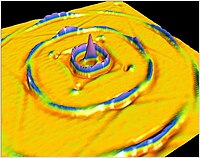
Photo from wikipedia
Basins with thick sediments can amplify and prolong the incoming seismic waves, which may cause serious damage to surface facilities. The amplification of seismic energy depends on the shear-wave velocity… Click to show full abstract
Basins with thick sediments can amplify and prolong the incoming seismic waves, which may cause serious damage to surface facilities. The amplification of seismic energy depends on the shear-wave velocity of the uppermost layers, which is generally estimated through surface wave analysis. Surface waves may propagate in different modes, and the mechanism of the mode development is not well understood. Exploiting a recently deployed permanent airgun source in the Hutubi basin, Xinjiang, northwest China, we conducted a field experiment to investigate the development of multimode surface waves. We observed surface waves at the frequency of 0.3–5.0 Hz with apparent group velocities of 200–900 m/s, and identified five modes of surface waves (three Rayleigh-wave modes and two Love-wave modes) through time–frequency and particle-motion analyses. We then measured 125 group velocity dispersion curves of the fundamental- and higher-mode surface waves, and further inverted the 1D S-wave velocity structure of the Hutubi basin. The S-wave velocity increases abruptly from 238 m/s at the surface to 643 m/s at 300 m depth. Synthetic seismograms with the inverted velocity structure capture the main features of the surface waves of the different modes. Synthetic tests suggest that the low velocity, high velocity gradient, and shallow source depth are likely the dominant contributing factors in the development of higher-mode surface waves.
Journal Title: Bulletin of the Seismological Society of America
Year Published: 2021
Link to full text (if available)
Share on Social Media: Sign Up to like & get
recommendations!